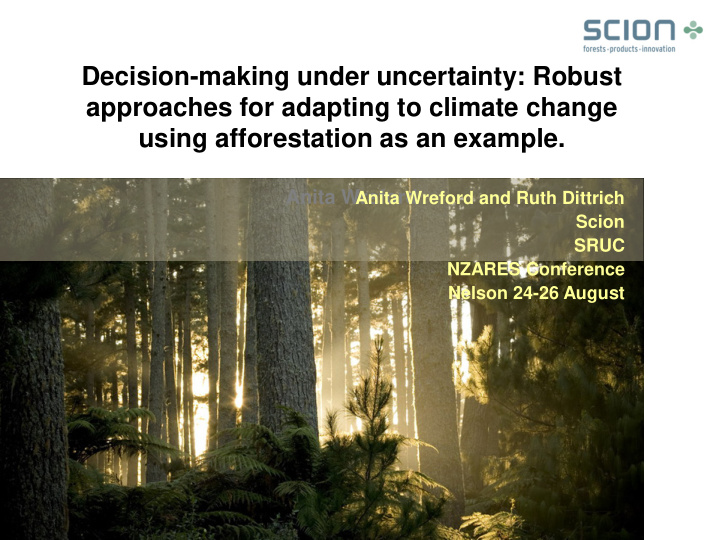



Decision-making under uncertainty: Robust approaches for adapting to climate change using afforestation as an example. Anita Wreford Anita Wreford and Ruth Dittrich Scion SRUC NZARES Conference Nelson 24-26 August
Outline 1. Uncertainty in climate change analysis 2. Robust decision-making under uncertainty − Real Options Analysis − Portfolio Analysis − Robust Decision-Making 3. Real-options analysis for natural flood management 4. Future directions
Climate change is uncertain • Uncertainties in timing, magnitude and location of changes Future society GHG The cascade of uncertainty emissions Climate model Regional scenario Impact model Local impacts Wilby and Dessai (2010) Adaptation responses The envelope of uncertainty
• But decisions still need to be made • ‘Robust’ under uncertainty: - flexible - reversible - win-wins - avoiding lock-in - soft rather than hard strategies
Long-term adaptation options • In anticipation of climate change: • Decisions where adaptation requires a longer time to be fully effective (long lead time), or long life time ((partial) irreversibility) • E.g. flood protection schemes, river basin management, infrastructure. • BUT: Cost may be immediate and benefits uncertain.
Robust decision making methods Robust approaches select projects that meet their purpose across a variety of plausible futures (Hallegatte et al., 2012). • Robust approaches do not assume a single climate change forecast but integrate a wide range of climate scenarios through a. Finding the least vulnerable strategy across scenarios (Robust Decision Making). b. Diversifying adaptation options to reduce overall risk (Portfolio Analysis). c. Defining flexible, adjustable strategies (Real Options Analysis).
Real options analysis • Similar to CBA but additionally values the option to wait/to be flexible depending on the uncertain parameter (climate change). • For large (partly) irreversible investments with an opportunity cost to waiting i.e. if there is a need for action in the present • When there is a significant chance of over- or underinvesting, • Where uncertainty is likely to resolve over time
Real Options Analysis (ROA) application to natural flood management in Scottish borders • NFM involves the utilisation or restoration of ‘natural’ land cover and channel-floodplain features within catchments to increase the time to peak and reduce the height of the flood wave downstream • Effectiveness diminishes as storm intensity increases and is more pronounced for small catchments • Rapidly rising up policy agenda in Europe
Research Question • how to sequence the flood risk management measure so that it prevents flooding in a 1 in 20 year rainfall event in a way that minimises the expected life-time cost of the system • In this case the flood risk management measure is the hectares of trees planted • The aim is to avoid both under and over-investment, which either results in a flood protection standard below the 1/20 year flood event or flood regulation capacity above the required standard
ROA steps • Specify the decision-tree • Identify the potential options • Formulate the optimisation objective • Solve the optimisation problem
Data • Use the underlying distribution of the UKCP09 climate change data (Murphy et al., 2009). • Weather generator and random number sampling to produce long time series of statistically plausible daily and hourly weather data . • Hydrological model • Chose medium climate scenario (likely to be conservative)
Solve the optimisation problem • Can be solved by dynamic (stochastic) programming • Simplified version using backward induction in spreadsheet • Costs = cost of planting and maintenance, opportunity cost of alternative land use (sheep) • Damage cost = cost of a 1/20 RP flood event.
Results • The cost of the expected flexible strategy is shown to be about 65 % cheaper (£5.3 mil) than the worst case strategy, (£15.6m), i.e. planting for the worst case outcome in 2016 • Results are driven by the high maintenance cost within the system relative to the damage cost for most configurations. • Could add additional decision nodes allowing for more frequent planting - but would significantly increase the complexity • Didn’t include ecosystem service benefits which would likely shift the decision towards earlier investment • More conceptual application for policy-making?
ecision tree for tea Action point ACT LATER ACT NOW 2020s 2030s Existing areas/current Increasing decline in quality, falling market price plans Focus on existing sites Addressing current Mulching Quality But in longer-term options variability and building maintained, additional actions my be resilience Tree belts, shade trees g Price protected required (see long-term planning) Capacity building New slope planting Focus on tea expansion New sites into full production mid 2020s plans Minimize lock-in and Minimum altitude for planting regrets/keep options (rule based – avoid low Future site quality g open elevation maintained, price and New plantations sited with Portfolio strategy payback protected hedging strategy (portfolio p approach) Flexibility /robustness Focus on future actions and Learn for the future decisions Meteorological measurement, Siting of new Adaptive planning for risk mapping and info, plantations future risks planning Future Changes in practice monitoring large-scale Pest and disease monitoring or new Scale-up integrated Monitoring & learning and climate analysis. IPM threats pest management piloting addressed Research Research into new varieties Roll-out new varieties Increase in Current ~0.50 ° C ~1.00 ° C temperature (T=0)
Related reading • Dittrich, R, Ball, T., Butler, A., Moran, D. 2016. Economic appraisal of afforestation for flood management under climate change and associated benefits. Working paper. Edinburgh: SRUC. • Dittrich, R., Wreford, A., Butler, A., Moran, D (2016).The impact of flood action groups on the uptake of flood management measures. Climatic Change DOI 10.1007/s10584-016-1752-8 • Dittrich, R., Wreford, A., Moran, D. 2016. A survey of decision-making approaches for climate change adaptation: Are robust methods the way forward? Ecological Economics, 122 , 79–89
Recommend
More recommend